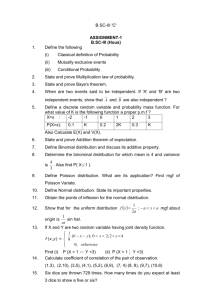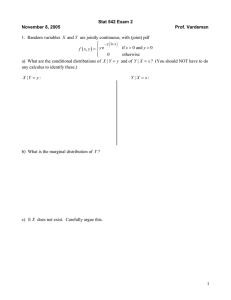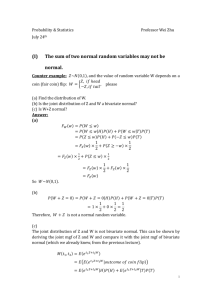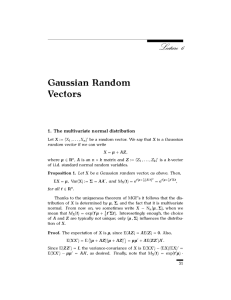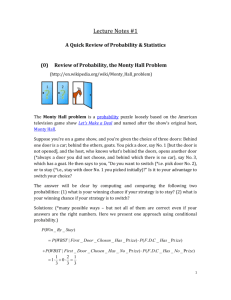docx - Tsinghua Math Camp 2015
advertisement
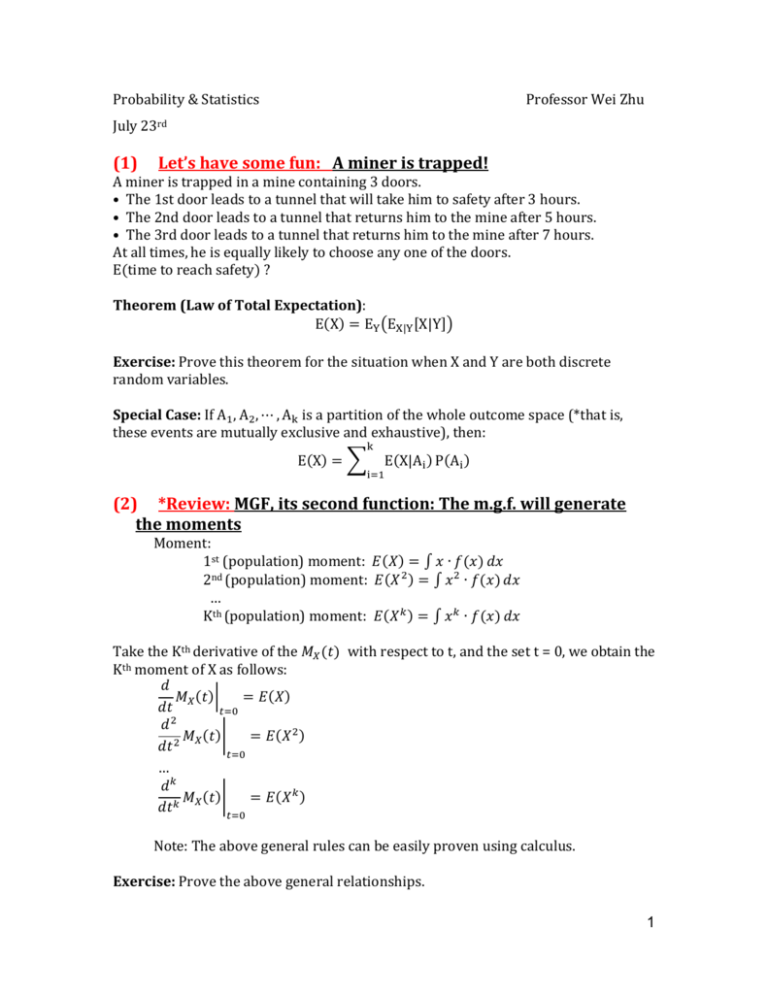
Probability & Statistics
Professor Wei Zhu
July 23rd
(1)
Let’s have some fun: A miner is trapped!
A miner is trapped in a mine containing 3 doors.
• The 1st door leads to a tunnel that will take him to safety after 3 hours.
• The 2nd door leads to a tunnel that returns him to the mine after 5 hours.
• The 3rd door leads to a tunnel that returns him to the mine after 7 hours.
At all times, he is equally likely to choose any one of the doors.
E(time to reach safety) ?
Theorem (Law of Total Expectation):
E(X) = EY (EX|Y [X|Y])
Exercise: Prove this theorem for the situation when X and Y are both discrete
random variables.
Special Case: If A1 , A2 , ⋯ , Ak is a partition of the whole outcome space (*that is,
these events are mutually exclusive and exhaustive), then:
k
E(X) = ∑
E(X|Ai ) P(Ai )
i=1
(2) *Review: MGF, its second function: The m.g.f. will generate
the moments
Moment:
1st (population) moment: 𝐸(𝑋) = ∫ 𝑥 ∙ 𝑓(𝑥) 𝑑𝑥
2nd (population) moment: 𝐸(𝑋 2 ) = ∫ 𝑥 2 ∙ 𝑓(𝑥) 𝑑𝑥
…
Kth (population) moment: 𝐸(𝑋 𝑘 ) = ∫ 𝑥 𝑘 ∙ 𝑓(𝑥) 𝑑𝑥
Take the Kth derivative of the 𝑀𝑋 (𝑡) with respect to t, and the set t = 0, we obtain the
Kth moment of X as follows:
𝑑
𝑀 (𝑡)|
= 𝐸(𝑋)
𝑑𝑡 𝑋
𝑡=0
𝑑2
𝑀 (𝑡)|
= 𝐸(𝑋 2 )
𝑑𝑡 2 𝑋
𝑡=0
…
𝑑𝑘
𝑀 (𝑡)|
= 𝐸(𝑋 𝑘 )
𝑑𝑡𝑘 𝑋
𝑡=0
Note: The above general rules can be easily proven using calculus.
Exercise: Prove the above general relationships.
1
Example (proof of a special case): When ~𝑁(𝜇, 𝜎 2 ) , we want to verify the above
equations for k=1 & k=2.
𝑑
𝑀 (𝑡)|
𝑑𝑡 𝑋
𝑡=0
1 2 2
𝑡
= (𝑒 𝜇𝑡+2𝜎
) ∙ (𝜇 + 𝜎 2 𝑡) (using the chain rule)
So when t=0
𝑑
𝑀 (𝑡)|
= 𝜇 = 𝐸(𝑋)
𝑑𝑡 𝑋
𝑡=0
𝑑2
𝑑 𝑑
(𝑡)
𝑀
=
[ 𝑀 (𝑡)]
𝑋
𝑑𝑡 2
𝑑𝑡 𝑑𝑡 𝑋
1 2 2
𝑑
= [(𝑒 𝜇𝑡+2𝜎 𝑡 ) ∙ (𝜇 + 𝜎 2 𝑡)] (using the result of the Product Rule)
𝑑𝑡
1 2 2
1 2 2
= (𝑒 𝜇𝑡+2𝜎 𝑡 ) ∙ (𝜇 + 𝜎 2 𝑡)2 + (𝑒 𝜇𝑡+2𝜎 𝑡 ) ∙ 𝜎 2
𝑑2
𝑀 (𝑡)|
= 𝜇 2 + 𝜎 2 = 𝐸(𝑋 2 )
𝑑𝑡 2 𝑋
𝑡=0
Considering 𝜎 2 = Var(X) = E(𝑋 2 ) − 𝜇 2
*(3). Review: Joint distribution, and independence
Definition. The joint cdf of two random variables X and Y are defined as:
𝐹𝑋,𝑌 (𝑥, 𝑦) = 𝐹(𝑥, 𝑦) = 𝑃(𝑋 ≤ 𝑥, 𝑌 ≤ 𝑦)
Definition. The joint pdf of two discrete random variables X and Y are defined as:
𝑓𝑋,𝑌 (𝑥, 𝑦) = 𝑓(𝑥, 𝑦) = 𝑃(𝑋 = 𝑥, 𝑌 = 𝑦)
Definition. The joint pdf of two continuous random variables X and Y are defined
as:
𝜕2
𝑓𝑋,𝑌 (𝑥, 𝑦) = 𝑓(𝑥, 𝑦) = 𝜕𝑥𝜕𝑦 𝐹(𝑥, 𝑦)
Definition. The marginal pdf of the discrete random variable X or Y can be obtained
by summation of their joint pdf as the following: 𝑓𝑋 (𝑥) = ∑𝑦 𝑓(𝑥, 𝑦) ; 𝑓𝑌 (𝑦) =
∑𝑥 𝑓(𝑥, 𝑦) ;
Definition. The marginal pdf of the continuous random variable X or Y can be
∞
obtained by integration of the joint pdf as the following: 𝑓𝑋 (𝑥) = ∫−∞ 𝑓(𝑥, 𝑦) 𝑑𝑦;
∞
𝑓𝑌 (𝑦) = ∫−∞ 𝑓(𝑥, 𝑦) 𝑑𝑥;
Definition. The conditional pdf of a random variable X or Y is defined as:
2
𝑓(𝑥, 𝑦)
𝑓(𝑥, 𝑦)
; 𝑓(𝑦|𝑥) =
𝑓(𝑦)
𝑓(𝑥)
Definition. The joint moment generating function of two random variables X and Y
is defined as
𝑀𝑋,𝑌 (𝑡1 , 𝑡2 ) = 𝐸(𝑒 𝑡1 𝑋+𝑡2 𝑌 )
Note that we can obtain the marginal mgf for X or Y as follows:
𝑀𝑋 (𝑡1 ) = 𝑀𝑋,𝑌 (𝑡1 , 0) = 𝐸(𝑒 𝑡1 𝑋+0∗𝑌 ) = 𝐸(𝑒 𝑡1 𝑋 ); 𝑀𝑌 (𝑡2 ) = 𝑀𝑋,𝑌 (0, 𝑡2 ) = 𝐸(𝑒 0∗𝑋+𝑡2 ∗𝑌 )
= 𝐸(𝑒 𝑡2 ∗𝑌 )
𝑓(𝑥|𝑦) =
Theorem. Two random variables X and Y are independent ⇔ (if and only if)
𝐹𝑋,𝑌 (𝑥, 𝑦) = 𝐹𝑋 (𝑥)𝐹𝑌 (𝑦) ⇔ 𝑓𝑋,𝑌 (𝑥, 𝑦) = 𝑓𝑋 (𝑥)𝑓𝑌 (𝑦) ⇔ 𝑀𝑋,𝑌 (𝑡1 , 𝑡2 ) = 𝑀𝑋 (𝑡1 ) 𝑀𝑌 (𝑡2 )
Definition. The covariance of two random variables X and Y is defined as
𝐶𝑂𝑉(𝑋, 𝑌) = 𝐸[(𝑋 − 𝜇𝑋 )(𝑌 − 𝜇𝑌 )].
Theorem. If two random variables X and Y are independent, then we have
𝐶𝑂𝑉(𝑋, 𝑌) = 0. (*Note: However, 𝐶𝑂𝑉(𝑋, 𝑌) = 0 does not necessarily mean that X
and Y are independent.)
(4) *Definitions: population correlation & sample correlation
Definition: The population (Pearson Product Moment) correlation coefficient ρ is
defined as:
𝑐𝑜𝑣(𝑋, 𝑌)
𝜌=
√𝑣𝑎𝑟(𝑋) ∗ 𝑣𝑎𝑟(𝑌)
Definition: Let (X1 , Y1), …, (Xn , Yn) be a random sample from a given bivariate
population, then the sample (Pearson Product Moment) correlation coefficient r is
defined as:
𝑟=
∑(𝑋𝑖 − 𝑋̅)(𝑌𝑖 − 𝑌̅)
√[∑(𝑋𝑖 − 𝑋̅)2 ][∑(𝑌𝑖 − 𝑌̅)2 ]
3
Left: Karl Pearson FRS[1] (/ˈpɪərsən/; originally named Carl; 27 March 1857 – 27 April
1936[2]) was an influential English mathematician and biometrician.
Right: Sir Francis Galton, FRS (/ˈfrɑːnsɪs ˈɡɔːltən/; 16 February 1822 – 17 January 1911)
was a British Scientist and Statistician.
(5) *Definition: Bivariate Normal Random Variable
(𝑋, 𝑌)~𝐵𝑁(𝜇𝑋 , 𝜎𝑋2 ; 𝜇𝑌 , 𝜎𝑌2 ; 𝜌) where 𝜌 is the correlation between 𝑋 & 𝑌
The joint p.d.f. of (𝑋, 𝑌) is
1
1
𝑥 − 𝜇𝑋 2
𝑥 − 𝜇𝑋 𝑦 − 𝜇𝑦
𝑓𝑋,𝑌 (𝑥, 𝑦) =
exp {−
[(
) − 2𝜌 (
)(
)
2
2(1 − 𝜌 )
𝜎𝑋
𝜎𝑋
𝜎𝑌
2𝜋𝜎𝑋 𝜎𝑌 √1 − 𝜌2
𝑦 − 𝜇𝑌 2
+(
) ]}
𝜎𝑌
Exercise: Please derive the mgf of the bivariate normal distribution.
Q5. Let X and Y be random variables with joint pdf
1
1
𝑥 − 𝜇𝑋 2
𝑥 − 𝜇𝑋 𝑦 − 𝜇𝑦
𝑓𝑋,𝑌 (𝑥, 𝑦) =
exp {−
[(
) − 2𝜌 (
)(
)
2
2(1 − 𝜌 )
𝜎𝑋
𝜎𝑋
𝜎𝑌
2𝜋𝜎𝑋 𝜎𝑌 √1 − 𝜌2
𝑦 − 𝜇𝑌 2
+(
) ]}
𝜎𝑌
Where −∞ < 𝑥 < ∞, −∞ < 𝑦 < ∞. Then X and Y are said to have the bivariate
normal distribution. The joint moment generating function for X and Y is
1
𝑀(𝑡1 , 𝑡2 ) = exp [𝑡1 𝜇𝑋 + 𝑡2 𝜇𝑌 + (𝑡12 𝜎𝑋2 + 2𝜌𝑡1 𝑡2 𝜎𝑋 𝜎𝑌 + 𝑡22 𝜎𝑌2 )]
2
.
(a) Find the marginal pdf’s of X and Y;
(b) Prove that X and Y are independent if and only if ρ = 0.
4
(Here ρ is indeed, the <population> correlation coefficient between X and Y.)
(c) Find the distribution of(𝑋 + 𝑌).
(d) Find the conditional pdf of f(x|y), and f(y|x)
Solution:
(a)
The moment generating function of X can be given by
1
𝑀𝑋 (𝑡) = 𝑀(𝑡, 0) = 𝑒𝑥𝑝 [𝜇𝑋 𝑡 + 𝜎𝑋2 𝑡 2 ].
2
Similarly, the moment generating function of Y can be given by
1
𝑀𝑌 (𝑡) = 𝑀(𝑡, 0) = 𝑒𝑥𝑝 [𝜇𝑌 𝑡 + 𝜎𝑌2 𝑡 2 ].
2
Thus, X and Y are both marginally normal distributed, i.e.,
𝑋~𝑁(𝜇𝑋 , 𝜎𝑋2 ), and 𝑌~𝑁(𝜇𝑌 , 𝜎𝑌2 ).
The pdf of X is
𝑓𝑋 (𝑥) =
The pdf of Y is
𝑓𝑌 (𝑦) =
1
√2𝜋𝜎𝑋
1
√2𝜋𝜎𝑌
𝑒𝑥𝑝 [−
𝑒𝑥𝑝 [−
(𝑥 − 𝜇𝑋 )2
2𝜎𝑋2
(𝑦 − 𝜇𝑌 )2
2𝜎𝑌2
].
].
(b)
If𝜌 = 0, then
1
𝑀(𝑡1 , 𝑡2 ) = exp [𝜇𝑋 𝑡1 + 𝜇𝑌 𝑡2 + (𝜎𝑋2 𝑡12 + 𝜎𝑌2 𝑡22 )] = 𝑀(𝑡1 , 0) ∙ 𝑀(0, 𝑡2 )
2
Therefore, X and Y are independent.
If X and Y are independent, then
1
𝑀(𝑡1 , 𝑡2 ) = 𝑀(𝑡1 , 0) ∙ 𝑀(0, 𝑡2 ) = exp [𝜇𝑋 𝑡1 + 𝜇𝑌 𝑡2 + (𝜎𝑋2 𝑡12 + 𝜎𝑌2 𝑡22 )]
2
1 2 2
= exp [𝜇𝑋 𝑡1 + 𝜇𝑌 𝑡2 + (𝜎𝑋 𝑡1 + 2𝜌𝜎𝑋 𝜎𝑌 𝑡1 𝑡2 + 𝜎𝑌2 𝑡22 )]
2
Therefore, 𝜌 = 0
(c)
𝑀𝑋+𝑌 (𝑡) = 𝐸[𝑒 𝑡(𝑋+𝑌) ] = 𝐸[𝑒 𝑡𝑋+𝑡𝑌 ]
Recall that 𝑀(𝑡1 , 𝑡2 ) = 𝐸[𝑒 𝑡1 𝑋+𝑡2 𝑌 ], therefore we can obtain 𝑀𝑋+𝑌 (𝑡)by 𝑡1 = 𝑡2 =
𝑡 in 𝑀(𝑡1 , 𝑡2 )
That is,
5
1
𝑀𝑋+𝑌 (𝑡) = 𝑀(𝑡, 𝑡) = exp [𝜇𝑋 𝑡 + 𝜇𝑌 𝑡 + (𝜎𝑋2 𝑡 2 + 2𝜌𝜎𝑋 𝜎𝑌 𝑡 2 + 𝜎𝑌2 𝑡 2 )]
2
1 2
= exp [(𝜇𝑋 + 𝜇𝑌 )𝑡 + (𝜎𝑋 + 2𝜌𝜎𝑋 𝜎𝑌 + 𝜎𝑌2 )𝑡 2 ]
2
∴ 𝑋 + 𝑌 ~𝑁(𝜇 = 𝜇𝑋 + 𝜇𝑌 , 𝜎 2 = 𝜎𝑋2 + 2𝜌𝜎𝑋 𝜎𝑌 + 𝜎𝑌2 )
(d)
The conditional distribution of X given Y=y is given by
𝑓(𝑥|𝑦) =
𝑓(𝑥, 𝑦)
1
=
𝑒𝑥𝑝 −
𝑓(𝑦)
√2𝜋𝜎𝑋 √1 − 𝜌2
2
𝜎
(𝑥 − 𝜇𝑋 − 𝜎𝑋 𝜌(𝑦 − 𝜇𝑌 ))
𝑌
{
Similarly, we have the conditional distribution of Y given X=x is
𝑓(𝑦|𝑥) =
𝑓(𝑥, 𝑦)
1
=
𝑒𝑥𝑝 −
𝑓(𝑥)
√2𝜋𝜎𝑌 √1 − 𝜌2
}
2
𝜎
(𝑦 − 𝜇𝑌 − 𝜎𝑌 𝜌(𝑥 − 𝜇𝑋 ))
𝑋
2(1 − 𝜌2 )𝜎𝑌2
{
Therefore:
.
2(1 − 𝜌2 )𝜎𝑋2
.
}
𝜎𝑋
(𝑦 − 𝜇𝑌 ), (1 − 𝜌2 )𝜎𝑋2 )
𝜎𝑌
𝜎𝑌
𝑌|𝑋 = 𝑥 ~ 𝑁 (𝜇𝑌 + 𝜌 (𝑥 − 𝜇𝑋 ), (1 − 𝜌2 )𝜎𝑌2 )
𝜎𝑋
𝑋|𝑌 = 𝑦 ~ 𝑁 (𝜇𝑋 + 𝜌
Exercise:
1. Linear transformation : Let X ~ N ( , 2 ) and Y a X b , where a&b are
constants, what is the distribution of Y?
2. The Z-Score Distribution: Let X ~ N ( , 2 ) , and Z
X
a
1
,b
What is the distribution of Z?
3. Distribution of the Sample Mean:
If X 1 , X 2 ,
i .i . d .
, X n ~ N ( , 2 ) , prove that X ~ N ( ,
2
n
).
6
4. Some musing over the weekend: We know from the bivariate normal
distribution that if X and Y follow a joint bivariate nornmal distribution,
then each variable (X or Y) is univariate normal, and furthermore, their
sum, (X+Y) also follows a univariate normal distribution. Now my question
is, do you think the sum of any two (univariate) normal random variables
(*even for those who do not have a joint bivriate normal distribution),
would always follow a univariate normal distribution? Prove you claim if
you answer is Yes, and provide at least one counter example if your answer
is no.
Exercise -- Solutions:
1. Linear transformation : Let X ~ N ( , 2 ) and Y a X b , where a&b are
constants, what is the distribution of Y?
Solution:
M Y (t ) E (e tY ) E[e t ( aX b ) ] E (e atX bt ) E (e atX e bt )
e E (e
bt
atX
) e e
bt
at
a 2 2t 2
2
exp[( a b)t
a 2 2 t 2
]
2
Thus,
Y ~ N (a b, a 2 2 )
2. Distribution of the Z-score:
Let X ~ N ( , 2 ) , and Z
X
a
1
,b
What is the distribution of Z?
Solution (1), the mgf approach:
M Z (t ) e
t
1
1
1
1
t
( t ) 2 ( t )2
t2
1
M X ( t) e e 2 e 2
→ m.g.f. for N (0,1)
Thus, Z
X
~ N (0,1)
7
Now with one standard normal table, we will be able to calculate the probability of
any normal random variable:
P ( a X b) P (
P(
a
a
X
Z
b
b
)
)
Solution (2), the c.d.f. approach:
FZ ( z ) P( Z z ) P(
X
z)
P( X z ) FX ( z )
f Z ( z)
d
d
FZ ( z )
FX ( z ) f X ( z )
dz
dz
1
e
2
( z ) 2
2 2
z2
1 2
e → the p.d.f. for N(0,1)
2
Solution (3), the p.d.f. approach:
1
f X ( x)
2
e
( x )2
2 2
x z
Let the Jacobian be J:
J
dx d
( z )
dz dz
1
f z ( z ) | J | f x ( x)
e
2
Z
X
( x )2
2 2
1
e
2
X ~ N ( ,
n
2
1 z2
e
2
~ N (0,1)
3. Distribution of the Sample Mean: If X 1 , X 2 ,
2
( z )2
2 2
i .i . d .
, X n ~ N ( , 2 ) , then
).
Solution:
M X (t ) E (e tX ) E (e
t
X 1 X 2 X n
n
)
8
= E (et
*
( X1 X n )
), where t * t / n,
M X1 X n (t * ) M X1 (t * )M X n (t * )
(e
e
X ~ N ( ,
1
2
t * 2t *2
)n
t 1
t
n n 2 ( ) 2
n 2
n
e
t
1 2 2
t
2 n
2
n
)
9

